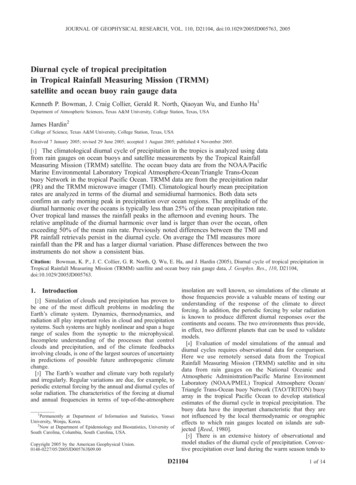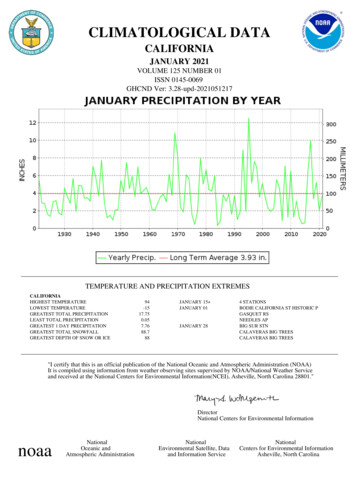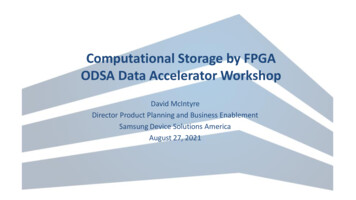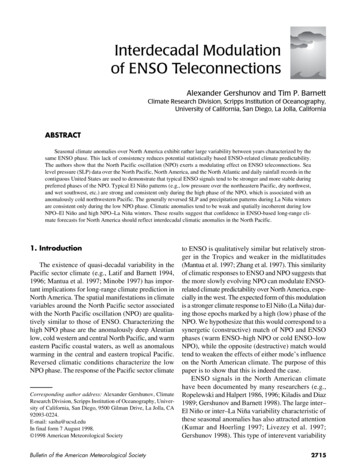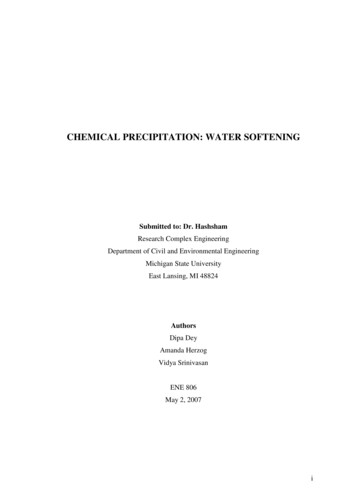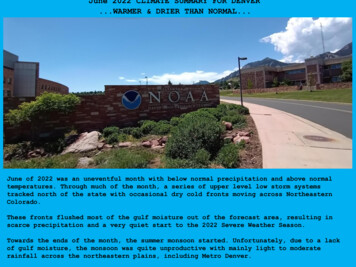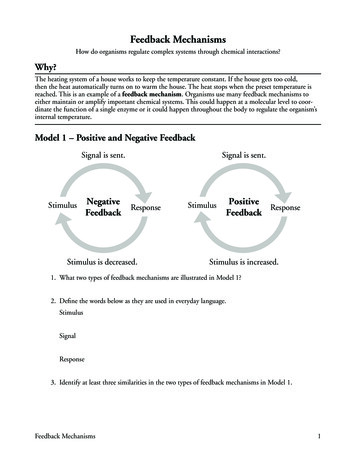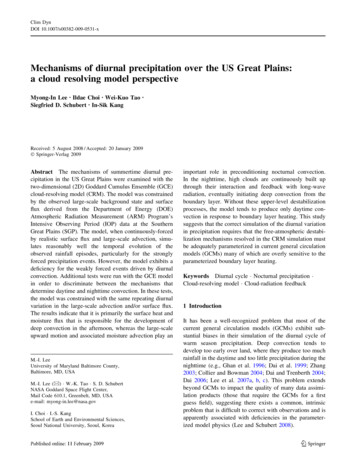
Transcription
Clim DynDOI 10.1007/s00382-009-0531-xMechanisms of diurnal precipitation over the US Great Plains:a cloud resolving model perspectiveMyong-In Lee Æ Ildae Choi Æ Wei-Kuo Tao ÆSiegfried D. Schubert Æ In-Sik KangReceived: 5 August 2008 / Accepted: 20 January 2009Ó Springer-Verlag 2009Abstract The mechanisms of summertime diurnal precipitation in the US Great Plains were examined with thetwo-dimensional (2D) Goddard Cumulus Ensemble (GCE)cloud-resolving model (CRM). The model was constrainedby the observed large-scale background state and surfaceflux derived from the Department of Energy (DOE)Atmospheric Radiation Measurement (ARM) Program’sIntensive Observing Period (IOP) data at the SouthernGreat Plains (SGP). The model, when continuously-forcedby realistic surface flux and large-scale advection, simulates reasonably well the temporal evolution of theobserved rainfall episodes, particularly for the stronglyforced precipitation events. However, the model exhibits adeficiency for the weakly forced events driven by diurnalconvection. Additional tests were run with the GCE modelin order to discriminate between the mechanisms thatdetermine daytime and nighttime convection. In these tests,the model was constrained with the same repeating diurnalvariation in the large-scale advection and/or surface flux.The results indicate that it is primarily the surface heat andmoisture flux that is responsible for the development ofdeep convection in the afternoon, whereas the large-scaleupward motion and associated moisture advection play anM.-I. LeeUniversity of Maryland Baltimore County,Baltimore, MD, USAM.-I. Lee (&) W.-K. Tao S. D. SchubertNASA Goddard Space Flight Center,Mail Code 610.1, Greenbelt, MD, USAe-mail: myong-in.lee@nasa.govI. Choi I.-S. KangSchool of Earth and Environmental Sciences,Seoul National University, Seoul, Koreaimportant role in preconditioning nocturnal convection.In the nighttime, high clouds are continuously built upthrough their interaction and feedback with long-waveradiation, eventually initiating deep convection from theboundary layer. Without these upper-level destabilizationprocesses, the model tends to produce only daytime convection in response to boundary layer heating. This studysuggests that the correct simulation of the diurnal variationin precipitation requires that the free-atmospheric destabilization mechanisms resolved in the CRM simulation mustbe adequately parameterized in current general circulationmodels (GCMs) many of which are overly sensitive to theparameterized boundary layer heating.Keywords Diurnal cycle Nocturnal precipitation Cloud-resolving model Cloud-radiation feedback1 IntroductionIt has been a well-recognized problem that most of thecurrent general circulation models (GCMs) exhibit substantial biases in their simulation of the diurnal cycle ofwarm season precipitation. Deep convection tends todevelop too early over land, where they produce too muchrainfall in the daytime and too little precipitation during thenighttime (e.g., Ghan et al. 1996; Dai et al. 1999; Zhang2003; Collier and Bowman 2004; Dai and Trenberth 2004;Dai 2006; Lee et al. 2007a, b, c). This problem extendsbeyond GCMs to impact the quality of many data assimilation products (those that require the GCMs for a firstguess field), suggesting there exists a common, intrinsicproblem that is difficult to correct with observations and isapparently associated with deficiencies in the parameterized model physics (Lee and Schubert 2008).123
M.-I. Lee et al.: Mechanisms of diurnal precipitation over the US Great PlainsA number of previous studies suggest that the centralproblem has to do with deficiencies in the deep convectionscheme (e.g., Xie and Zhang 2000; Zhang 2003; Lee et al.2007a among many others). The predominance of daytimeprecipitation over land suggests that the models are overlysensitive to the diurnal heating in the planetary boundarylayer (PBL). A majority of the convection schemes currently implemented in GCMs are based on a closureassumption tied to the convective available potentialenergy (CAPE) (e.g., Arakawa and Schubert 1974). CAPEis defined as the amount of energy an air parcel would haveif lifted a certain distance vertically through the atmosphere. It measures the convective instability of a givencolumn (basically influenced by both the boundary layerand free-atmospheric large-scale processes), and is mostefficiently built up during the daytime as the PBL growswith the heating at the ground. On the other hand, CAPE isreduced and convection is suppressed in the model duringthe night in association with the large negative buoyancylinked to nighttime surface cooling. In order to overcomethis large negative buoyancy, a certain external source ofenergy must be provided for triggering convection (Kainand Fritsch 1992). In this regard, Xie and Zhang (2000)argued that CAPE would be a necessary, but not a sufficient condition for initiating deep convection.It is clear that there must exist other destabilizationmechanisms in nature that complicate the diurnalresponse of deep convection. In particular, it appears thatthe large-scale circulation plays an important role insuppressing, triggering, organizing and dissipating theconvective systems (e.g., Silva Dias et al. 1987; Higginset al. 1997; Carbone and Tuttle 2008). Those mechanismsare often implemented as ad hoc convection triggers and/or inhibition functions that are meant to be simple surrogates for nature’s more complex large-scale controls onthe deep convection (e.g., Xie and Zhang 2000; Zhang2003; Lee et al. 2008). For example, several models haveincorporated a dependency on the large-scale verticalmotion in such a way as to trigger deep convection orexpedite the consumption of the convective instability inthe presence of large-scale ascending motion (e.g., Fritschand Chappell 1980; Kain and Fritsch 1992; Pan and Wu1995; Hong and Pan 1998). Such implementations areusually incomplete, however, and have only shown marginal improvements to the simulated diurnal cycle.Indeed, the two-way interaction between the large-scaleenvironment and convection remains as an unresolvedproblem, limiting our ability to parameterize the processof deep convection in coarse-grid GCMs. The abovediscussion suggests that there is a need for a more comprehensive framework that could facilitate an improvedunderstanding of the linkages between convection and thelarge-scale environment.123Cloud-resolving models (CRMs) have definite advantages over parameterized GCMs in studying the impacts oflarge-scale environments on the development of cumulusconvection, since they do not include any causalityassumption between them. Those models are now beingwidely tested and embedded in several GCMs in place ofparameterized convection and cloud processes (oftenreferred to as superparameterization, Grabowski andSmolarkiewicz 1999; Randall et al. 2003). CRMs are alsoused for diagnosing problems with the GCM parameterizations (e.g., Guichard et al. 2004; Chaboureau et al. 2004;Xie et al. 2005). In this study, we investigate the importantforcing mechanisms that drive the diurnal variation inconvection, with a specific focus on examining the roles ofthe boundary heating and the large-scale dynamics in initiating deep convection.Using the CRM, we specifically target the simulation ofsummertime precipitation over the US Great Plains. One ofour primary objectives is to enhance our understandingof the observed nocturnal precipitation maximum in thatregion (Wallace 1975)—a region where most GCMs fail tocapture this pronounced signal. Previous observationstudies suggest that several mechanisms could explain thenocturnal precipitation maximum over the US Great Plains.One distinctive feature is the systematic delay in timing ofthe diurnal precipitation maximum eastward from theRockies to the adjacent Plains (Riley et al. 1987; Carboneet al. 2002; Nesbitt and Zipser 2003; Carbone and Tuttle2008; etc.). Carbone et al. (2002) suggested that nocturnalprecipitation over the Plains is mainly associated witheastward propagating convective episodes, where thepropagation speed is close to that of gravity waves. In anupdated observational study, Carbone and Tuttle (2008)confirmed their previous findings and suggested thatnocturnal precipitation is primarily determined by (1) thepassage of eastward-propagating rainfall systems thatform over the mountains; (2) the nocturnal reversal of amountain–plains circulation; and (3) nocturnal moistureconvergence driven by the low-level jet. In fact, the role ofthe nocturnal low-level jet has been emphasized in manyother studies (e.g., Helfand and Schubert 1995; Ghan et al.1996; Higgins et al. 1997; Schubert et al. 1998), highlighting the important regulation of diurnal convection onsub-continental scales.Our goal in this study is to improve our understanding ofthe mechanisms that drive the diurnal cycle of Great Plainsprecipitation, with the broader goal of improving theparameterization of the mechanisms that drive the diurnalcycle in current GCMs. We use a two-dimensional (2D)CRM with a zonal-vertical domain, forcing it with theobserved large-scale fields derived from the atmosphericradiation measurement (ARM) observations at the Southern Great Plains (SGP) sites. In particular, the forcing
M.-I. Lee et al.: Mechanisms of diurnal precipitation over the US Great Plainsconsists of three-hourly observations that include the largescale winds, the large-scale advection of temperature andmixing ratio of water vapor, and the surface sensible/latentheat fluxes (spatially uniform over the horizontal grids).We note that a version of the CRM similar to this was usedby Sui et al. (1998) and Tao et al. (2003) to study themechanisms of diurnal precipitation over the tropicaloceans.2 Model and experimentsThe model used in this study is the latest version of theGoddard Cumulus Ensemble (GCE) model (Tao et al.2003), originally developed by Tao and Simpson (1993). Itis an elastic, non-hydrostatic, cloud-resolving model withdetailed cloud microphysics that facilitates the study of thedevelopment of mesoscale convective systems and theirinteractions with large-scale dynamics. Prognostic variables include winds, potential temperature, perturbationpressure, turbulent kinetic energy, and mixing ratios of allwater phases (vapor, liquid and ice). The model has variousoptions for the ice cloud microphysics. The three-class ice(3ICE) scheme was used for this study, which treats icecloud, snow, and hail explicitly. The shortwave and longwave radiation schemes are fully interactive with cloudsbased on a comprehensive parameterization of opticalproperties for various types of hydrometeors (Tao et al.1996). The sub-grid scale turbulence parameterization isbased on Klemp and Wilhelmson (1978) and Soong andOgura (1980). Other details of the model are described inTao et al. (2003) and the references therein.The GCE model has been tested extensively both in 2D(e.g., Johnson et al. 2002) and three-dimensional (3D)configurations (e.g., Tao and Simpson 1989; Lang et al.2007; Zeng et al. 2007). In this study, we used the 2D(zonal and vertical) version. The model extends horizontally over a 128 km-long zonal domain with 1-km gridspacing, and vertically from the ground up to 20 km with41 vertical levels. The time step is 6 s. The CRM is runwith cyclic lateral boundary conditions—an option that iscommonly used to avoid reflection of gravity waves at thelateral boundaries and allow multi-day integrations. Themodel is forced only by the prescribed large-scale advection over the domain (there are no extra heat and moisturesources), and therefore avoids any unnecessary complications that would otherwise arise in computing themomentum and heat budgets (Soong and Tao 1980). Wenote that the domain size of 128 km is relatively small, andthe horizontal resolution of 1 km is moderate, comparedwith other recent CRM studies. However, the results arequalitatively consistent with those from runs with largerdomains (tested up to 512 km) and finer resolution (see‘‘Appendix’’). Johnson et al. (2002) and Khairoutdinov andRandall (2003) found a similar sensitivity to the changes inthe domain size and resolution in their CRM experiments.This study investigates the response of the GCE modelto the prescribed large-scale forcing derived from observational data, which varies continuously in time. We usedthe ARM IOP single-column model forcing data at SGP todrive the GCE and validate the model simulation. Thesedata contain three-hourly vertical sounding observationsthat were post-processed into area-averaged single profilesusing an objective analysis scheme developed by Zhangand Lin (1997). The values represent the mean ARM cloudand radiation test best (CART) domain rather than a singlepoint (Zhang et al. 2001). The forcing data also provide thesurface latent and sensible heat fluxes derived from sitewide averages of observed fluxes from the ARM energybalance bowen ratio (EBBR) stations. The reader is pointedto the description in Zhang et al. (2001) for the details inthe objective analysis procedure and the input data sourcefrom various observations.The first set of GCE experiments consists of modelsimulations with continuous observational forcing overeach IOP period. Three IOPs were selected for studying thewarm-season convective episodes and their time–meandiurnal variation. These consist of the summer periods of1995, 1997 and 1999. Each case has a different observingduration but together they make up about 55 days ofobservations. The large-scale forcing includes the zonaland meridional winds, vertical motion, and advection tendencies of temperature and moisture (water vapor mixingratio), which were prescribed uniformly over the modeldomain. For simplicity, surface sensible and latent heatfluxes were also prescribed uniformly by assuminghomogenous surface characteristics in the lower boundaryover the computation domain. The observed hourly surfaceprecipitation provided by the ARM forcing dataset wasused to validate the domain-averaged precipitation simulated by the GCE model. These data are based on theArkansan Basin Red River Forecast Center (ABRFC) 4-kmgridded rainfall analysis, which in turn are based on radarmeasurements that have been adjusted by the surface raingauge observations. The study also makes use of theobserved cloud fraction at the ARM SGP obtained from theCloud Modeling Best Estimate (CMBE) dataset. Thishourly cloud fraction was derived from the combinedestimate of the ARM millimeter-wave cloud radars(MMCR), micropulse lidars (MPL), and laser ceilometersmeasurements, and vertically gridded to a resolution of45 m beginning at 195 m above the ground.The second set of GCE experiments consists of moreidealized simulations in which the model is constrainedwith the same repeating diurnal variation of the large-scaleadvection and/or surface latent and sensible heat fluxes.123
M.-I. Lee et al.: Mechanisms of diurnal precipitation over the US Great PlainsThese are designed to discriminate between the mechanisms that determine daytime and nighttime convection.The prescribed forcing in this case was obtained by averaging the time-varying ARM forcing over all the IOPs,while retaining the diurnal variation. Sect. 3.2 providesfurther details about the experimental setting.Our approach is analogous to the single-column modelapproach used in GCMs. Cloud systems are explicitlysimulated in CRMs, and their collective responses as represented by a domain average can be straightforwardlycompared with the single-column GCM simulation that isdriven by identical large-scale advection and surface flux.A key limitation of this approach is in representing theobserved eastward propagation of mesoscale convectivesystems, which, as noted earlier, is one of the importantprocesses contributing to the nocturnal precipitation overthe US Great Plains (Maddox 1980; Riley et al. 1987;Carbone et al. 2002; Nesbitt and Zipser 2003). Specifically,a CRM with cyclic boundaries cannot adequately representthe propagation of waves or precipitating systems into thedomain from the outside. Those influences are only crudelyincluded in the prescribed large-scale advection forcing.Khairoutdinov and Randall (2003) indicate that the CRMcan severely underestimate the cloud fraction possiblybecause of its inability to account for the lateral advectionof clouds over the ARM site. Nevertheless, the resultsof this study should be valuable for identifying the keyprocesses that drive the diurnal cycle of convection, andshould be useful for improving the convective parameterizations in current GCMs.We first examine the ability of the GCE model to reproducevarious precipitation events that occurred during thethree summertime ARM IOPs, in response to the observedtime-varying large-scale atmospheric and surface boundaryforcing. Figure 1 compares the time variations of theobserved and simulated precipitation. The model simulation captures the temporal evolution of precipitation eventsand their magnitudes. For example, the model captures thestrong daily precipitation episodes during the early 1995IOP (19–26 July), followed by the dry period (27–31 July),and then followed by the longer-lasting wet period (1–3August). The model also shows reasonable simulations forthe other two IOPs, except for a few specific events (forexample, in 6–8 July 1997 and 16 July 1999).Although the model simulates the observations reasonably well, particularly for the strongly forced precipitationvariability that occurs on the time scale of a few days, itdoes less well in simulating the diurnal variations. Forexample, during 20–26 July 1995, when the observationshows very regular nocturnal precipitation events, themodel captures only half of those events with accuratetiming. The remaining events are misrepresented as daytime events. To get a better sense of the simulated diurnalcycle of precipitation, we constructed a time–mean 24-hdiurnal time series by averaging the precipitation amounthour by hour over the entire 55 days. Those results areFig. 1 Time series of three-hourly precipitation (mm day-1) fromthe observation (black) and the GCE model simulation (red) duringthree ARM IOPs in 1995, 1997, and 1999. The observation representsthe area average of precipitation over the ARM SGP ground stations,whereas the model simulation is the average over the wholecomputational domain1233 Results3.1 Test in the realistic case
M.-I. Lee et al.: Mechanisms of diurnal precipitation over the US Great Plainsshown in Fig. 2a and c. The observed precipitation amountshows a clear maximum in the nighttime centered on localmidnight (Fig. 2a), which is consistent with the resultsfrom other observational studies that analyzed longer precipitation records (e.g., Higgins et al. 1997). This feature ismore or less reproduced in the model simulation (Fig. 2c),but with a much smaller difference between the daytimeand nighttime values. On the other hand, the precipitatingevents, defined as the periods with precipitation greaterthan 1 mm day-1 for a given time of the day, are morefrequent during the late evening and nighttime in the ARMobservations (Fig. 2b), whereas the model shows thelargest frequency in the afternoon (Fig. 2d). Overall, thediurnal variation of the model precipitation from the55-day long time series is relatively flat and less prominentcompared with the observations.The above deficiencies in the simulated diurnal cycle ofprecipitation is consistent with what is found in manysingle-column GCM simulations, although the GCMsexhibit even stronger daytime precipitation (e.g., Guichardet al. 2004). This deficiency is likely in part due to the factthat the model configuration does not explicitly account forthe convective systems propagating into the domain—afeature that is also not present in single-column GCMs.Fig. 2 Diurnal variations of theprecipitation amount(mm day-1) and the frequencyof precipitation events largerthan 1 mm day-1. a and b arethe amount and frequency fromthe observation and c andd from the model simulation,respectively(a)(c)In the absence of convection propagating into the domain,the CRM requires explicit forcing to drive nocturnal convection, which in this case comes from the prescribedlarge-scale advection. This motivates us to turn to longertime integrations of the GCE model with idealized forcingfrom observations of the diurnal cycle to help gain furtherinsights into the diurnal precipitation mechanisms. Theinterpretation is that the CRM is responding as if it werea GCM grid cell to correct diurnal temperature and moisture tendencies. This provides a useful framework fortesting mechanisms that could be inserted into a GCM toproduce an improved simulation of the diurnal cycle ofprecipitation.3.2 Idealized casesFour idealized experiments were conducted with the GCEmodel and those are summarized in Table 1. Each experiment was integrated for 100 days, which was long enoughto obtain equilibrated statistics. In the first experiment(hereafter EXP1), the model was driven by the observedARM background forcing, consisting of the 46-day averages of IOP95 and IOP97 but retaining the diurnalvariation—we excluded the IOP99 in the average, simply(b)(d)123
M.-I. Lee et al.: Mechanisms of diurnal precipitation over the US Great PlainsTable 1 A description of the large-scale forcing prescribed to themodel in the four idealized experimentsExperiment ForcingEXP1Diurnally varying large-scale advection and surface fluxEXP2Diurnally varying surface flux with no large-scaleadvectionEXP3Diurnally varying large-scale advection with no surfacefluxEXP4Constant large-scale advection and surface fluxbecause of its short observing period having only oneprecipitating event. Therefore, the variability of time scaleslonger than a day is suppressed in the background forcingby design. Figure 3 shows the time-averaged large-scaleadvection of moisture and temperature (horizontal andvertical advections combined), vertical motion, and sensible and latent heat fluxes. Those were prescribed in theEXP1 run during the entire integration period. The second(EXP2) and the third (EXP3) experiments examine theindividual role of the large-scale atmospheric destabilization process and the surface flux in driving the diurnalvariation of precipitation. The EXP2 run used the samediurnally varying surface flux as EXP1 but with no largescale advection, whereas the model was driven with thediurnally varying large-scale atmospheric forcing in EXP3but with no surface flux. In the last experiment (EXP4), thediurnal variations of the large-scale forcing and the surfaceflux were averaged out from the configuration of EXP1,and the model was driven by time-invariant forcing.Diurnal variations of the precipitation amount andfrequency from the four experiments are compared in(a)(d)(b)(e)(c)Fig. 3 Time–mean diurnal variations of the large-scale advectiontendencies of a temperature (K day-1) and b moisture (g kg-1 day-1)c vertical motion (cm s-1), and the surface d sensible and e latent heat123fluxes (W m-2). The values are the averages of 46 days during theARM 1995 and 1997 IOPs
M.-I. Lee et al.: Mechanisms of diurnal precipitation over the US Great PlainsFig. 4 Diurnal variations of theprecipitation amount (leftpanels, unit: mm day-1) and thefrequency of precipitationevents larger than 1 mm day-1(right) from the four idealizedrunsFig. 4. Note that the time–mean total precipitationamount is approximately the same in EXP1 and EXP4(5.6 mm day-1), which is close to the sum of the other twoexperiments (EXP2: 3.3 and EXP3: 2.2 mm day-1). In allcases the timing of the peak in the diurnal cycle of precipitation amount is consistent with the peak in thefrequency. All of the experiments show clear diurnalvariations with, however, different peak timing. It isinteresting to see that EXP1 shows two peaks, one in theafternoon (around 1600 LT) and the other during the night(around 0500 LT). It turns out that this bimodal peak issimply a superposition of two distinct precipitation events(see next subsect.). On the other hand, EXP2 shows asingle peak at noon. The diurnal variation is quite oppositeto that in EXP3, where the nocturnal precipitation isdominated by a peak at 0600 LT with almost no precipitation in the afternoon during 1300–1700 LT. When theprescribed large-scale advection and the surface flux123
M.-I. Lee et al.: Mechanisms of diurnal precipitation over the US Great Plainscontain no diurnal variations (EXP4), the diurnal variationof precipitation is substantially suppressed. This suggeststhat those are the key processes to driving the diurnalvariation of precipitation in this cloud-resolving model.Note that, although not very prominent, the model doestend to produce slightly more rainfall in the nighttimein EXP4. We found that with time-invariant forcing themodel atmosphere becomes gradually unstable particularlythrough the constant surface flux in the boundary layeruntil it finally triggers convection to stabilize the atmosphere. Although the time-invariant surface flux eliminatesthe influence of diurnally varying surface solar radiation,the model atmosphere is still free to change by radiation. Inthis case the atmospheric longwave cooling can decreasethe stability at night and provide a favorable condition forthe nocturnal precipitation. On the other hand, atmosphericshortwave heating can increase the stability during thedaytime.The results from these idealized experiments provideevidence for two distinct mechanisms—one that drives thedaytime convection and another that drives nighttime convection. The diurnal variation of surface flux is mainlyresponsible for the development of convection in the afternoon. The sensible and latent heat fluxes reach their maximaaround local noon time (Fig. 3), which induce the PBLheating to increase the convective available potential energy(CAPE). Note that the precipitation frequency reaches up to80–90% during the peak time in EXP2, which suggests thatthe convection develops almost every day. This featurebasically corresponds to the behavior of many GCMs basedon the CAPE-type closure for deep convection (e.g., Leeet al. 2007a, b, c). On the other hand, the mechanismsresponsible for nocturnal precipitation must be largely related to the diurnal variation of large-scale atmosphericforcing, since the nocturnal precipitation events simulated inEXP1 disappeared in EXP2 and reappeared in EXP3. Thenocturnal peak is more pronounced in EXP3 when comparedwith EXP4, which suggests that the large-scale advectionacts to further destabilize the atmosphere in the nighttime inaddition to the nocturnal longwave cooling.The maximum development of precipitation betweenlate night and early morning in EXP1 and EXP3 coincideswith positive moisture advection and large-scale ascendingmotion in the lower troposphere below 700 hPa (seeFig. 3a–c), which can provide a favorable condition fordeep convection. However, whether or not these largescale atmospheric forcing actually triggers convection isnot clear. Indeed the forcing includes a semi-diurnalcomponent with the other peak occurring in the evening(1600–2000 LT), which is not necessarily accompanied byprecipitation. Instead, the simulated nocturnal precipitationoccurs after a large increase of moisture and ascendingmotion that peaks at 500 hPa during the nighttime due to123large-scale advection. Understanding the nocturnal precipitation mechanisms requires further analysis, which wediscuss next.4 DiscussionIn order to better understand the mechanisms for the daytime and nighttime precipitation, we examine EXP1 inmore detail. Figure 5 shows the diurnal composites ofprecipitation and vertical distribution of clouds for thedaytime and the nighttime precipitation days. For thedaytime composite, we first calculated the hourly timeseries of domain-averaged precipitation and cloud condensates, and then averaged over the days when theprecipitation exceeded 1 mm day-1 during 1400–1800 LT.The nighttime composite was done in a similar way butduring 0200–0600 LT. The composite analysis shows thatthe simulated precipitation events are well separatedbetween the daytime and the nighttime cases, implying thatthe bimodal peaks in Fig. 4a are simply a superposition oftwo distinct cases. The typical duration of the precipitationis 3–5 h for most of the simulated storms. The compositesalso show that the daytime precipitation events mostlydevelop after 1400 LT, reaching their diurnal maximumwithin 2 h or about 1600 LT. The decaying stage is slowerthan the developing stage, taking about 4 h before thesystems finally dissipate at 2000 LT. The fast developingstage of precipitation is associated with deep convectiveclouds rooted in the PBL, whereas the cumulus anvil-typehigh clouds are associated with the slowly decaying stage.This seems to represent a typical evolution of deep convection over land in the GCE. On the other hand, thenighttime rainfall cases involve precipitation more widelyspread in time from midnight to noon local time with amaximum at around 0400–0600 LT, and with an amplitudethat is weaker than for the daytime convection case. Wefound that the wide spread in time of precipitation does notnecessarily indicate a longer duration of individual precipitating events. The composite, in fact, suggests a weakerphase-locking of precipitation with the diurnal cycle thanfor the daytime precipitation case. Note that mid-to-highclouds form before nocturnal precipitation begins, suggesting a possible role of high clouds in producing topdown development of the nocturnal convection, comparedwith the bottom-up evolution of daytime convection.We next look in more detail at the life cycle of individual storms. Two storms representing the daytime andthe nighttime precipitation cases were examined followingtheir movements (Figs. 6, 7). Note that these are grid pointvalues at the center of t
passage of eastward-propagating rainfall systems that form over the mountains; (2) the nocturnal reversal of a mountain-plains circulation; and (3) nocturnal moisture convergence driven by the low-level jet. In fact, the role of the nocturnal low-level jet has been emphasized in many other studies (e.g., Helfand and Schubert 1995; Ghan et al.
